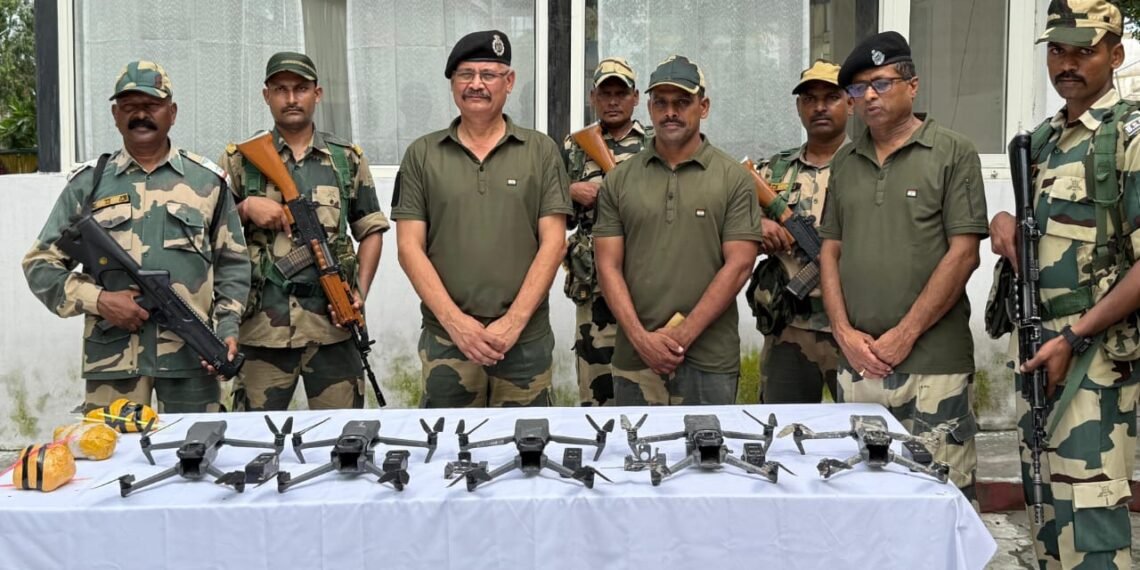The decision to form the drone squadron stems from the BSF’s experience during Operation Sindoor, launched in response to the April 22, 2025, Pahalgam terror attack that claimed 26 lives.
By PC Bureau
In a strategic response to escalating aerial threats, the Border Security Force (BSF) is raising its first-ever “drone squadron” to be deployed along the India-Pakistan border, sources confirmed on Tuesday.
The move, coupled with efforts to “harden” Border Outposts (BOPs) against lethal unmanned aerial vehicle (UAV) attacks, follows critical lessons learned during Operation Sindoor, a four-day conflict with Pakistan from May 7 to May 10, 2025.
This initiative marks a significant leap in India’s border security framework, addressing the growing menace of drone warfare.
The BSF’s maiden drone squadron will be stationed at strategic BOPs along the 3,323-km India-Pakistan border, spanning Gujarat, Rajasthan, Punjab, and Jammu and Kashmir.
The formation of the drone squadron sends a strong message to adversaries:
India is prepared to counter emerging threats with technological superiority and operational readiness. As the BSF rolls out these units and fortifies its defenses, the India-Pakistan border is poised to become a formidable barrier against drone incursions and terrorist activities.“This is not just about defense but about asserting our strategic edge,” the BSF official said. “We are ready to meet any challenge head-on.”
The squadron will comprise an advanced array of UAVs, including reconnaissance, surveillance, long-endurance precision attack drones, and kamikaze drones designed for rapid response and cross-border counter-assaults.
These units will be operated by specially-trained BSF personnel skilled in drone navigation, swarm tactics, signal jamming, and counter-drone operations.“The squadron is being established to neutralize enemy drones and enhance our offensive capabilities,” a senior BSF official said, speaking on condition of anonymity.
“A dedicated command center at the BSF’s Chandigarh battalion will oversee real-time operations, ensuring seamless coordination across the border.” The official added that the government has prioritized funding to fast-track the program, with personnel currently undergoing rigorous training to master advanced UAV technologies.
READ: Manipur’s Deadly Clash: Unraveling the UKNA–CKMA Bloodshed
The decision to form the drone squadron stems from the BSF’s experience during Operation Sindoor, launched in response to the April 22, 2025, Pahalgam terror attack that claimed 26 lives. India’s retaliatory strikes targeted terrorist and defense bases in Pakistan and Pakistan-occupied Kashmir (PoK), prompting Pakistan to deploy nearly 1,000 UAVs between May 7 and May 10 to attack Indian military and civilian installations. The BSF’s robust response—destroying over 118 Pakistani posts and dismantling their surveillance systems—highlighted its operational strength but also exposed vulnerabilities to drone-based assaults.A post-operation review underscored the need for specialized drone units and fortified defenses. “Pakistan’s use of drone swarms revealed the evolving nature of cross-border threats,” a defence expert opined.
“The BSF is adapting to this new reality by integrating cutting-edge technology and tactics.”
Hardening Border Defenses
In parallel, the BSF has initiated a comprehensive “hardening” of its BOPs to withstand lethal UAV attacks. This includes reinforcing structures with alloy sheets to protect against drone-dropped explosives and installing advanced counter-drone systems capable of detecting, tracking, and neutralizing rogue UAVs. These systems employ radar-blinding technology, signal jammers, and laser-based interceptors to disable enemy drones mid-flight.The BSF is collaborating with the Defence Research and Development Organisation (DRDO) and private defense firms to procure state-of-the-art anti-drone systems. “We are ensuring our BOPs are resilient against both conventional and aerial threats,” the BSF official noted.
The force is also upgrading surveillance infrastructure, including high-resolution cameras and motion sensors, to detect drone incursions in real time.
Rising Drone Threat
The urgency of these measures is driven by Pakistan’s increasing reliance on drones for cross-border smuggling and terrorism. In 2024, the BSF seized 294 drones in Punjab alone, up from 129 in 2023, with many carrying weapons, heroin, and explosives. On July 18, 2025, six Pakistani drones were intercepted in Punjab’s border districts, carrying 2.5 kg of heroin, underscoring the persistent challenge. Intelligence reports indicate that Pakistan’s deep state, often with Chinese-made drones, is arming terrorist groups in Punjab and Jammu and Kashmir, necessitating a robust counter-drone strategy.
The drone squadron and fortified BOPs represent a paradigm shift in India’s border security approach. “Drones have become a preferred tool for adversaries due to their low cost and deniability,” said a defense analyst. “The BSF’s initiative positions India to dominate the aerial domain along the western frontier.” The squadron’s ability to conduct surveillance, precision strikes, and counter-drone operations will enhance deterrence and enable proactive responses to cross-border threats.The BSF is also exploring collaborations with Indian startups and international firms to acquire advanced UAVs and anti-drone technologies. The Indian Army, which has been bolstering its own drone capabilities, will work in tandem with the BSF to ensure a cohesive defense strategy.













